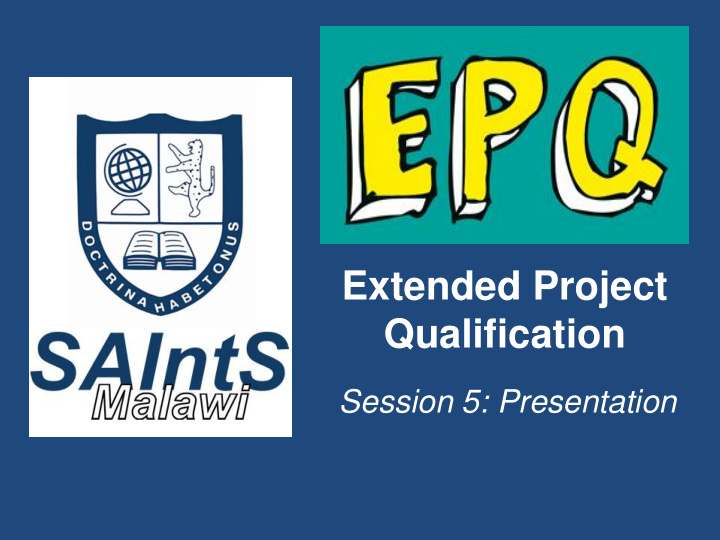



Extended Project Qualification Session 5: Presentation
Session 5: Key Questions What is the presentation and why do it? What is the structure and content of the presentation? What makes a good presentation?
What does a finished EPQ look like? • Your finished EPQ will have the following elements: A written report of 5,000 words or An artefact with a written report of 1,000-2,000 words. A fully completed Project Log documenting the stages of your project. A detailed Project Plan, Research Diary and Summary of Information. A Presentation Record form. Supporting documentation.
Credits • Many thanks to Mr Harbron at QEHS in the UK for sharing the following slides. • http://w1.qehs.net/moodle2/course/view.php?id=337 • I have made only minor alterations.
What are we doing today?. Today we will be looking at: – The content of an EPQ presentation – The structure of a presentation – The paperwork – What makes a good presentation There will be the opportunity for Q&A at the end…
Why do an EPQ Presentation? The EPQ Presentation is a compulsory part of the course. It is an opportunity to talk through your project and gain extra marks. The objective of the presentation is to give you a platform to show what you have done and how you have done it. In previous years, the presentation has allowed students to demonstrate that they have carried out work and gained skills which weren’t obvious in the written work.
What, to whom and when? Your EPQ Presentation should be: • A short presentation of approximately 10 minutes + time for questions at the end • To an audience consisting of your supervisor, a small group of students and maybe one other member of staff (EPQ Coordinator or school leader) • When your written report is complete and absolutely no later than Friday 10 th February 2017
What should it contain? The presentation should not only focus on the content of your project (the ‘product’), but should ideally also cover the following: • What your project is about • The reasoning that underpins your Project Product • Your Aims and Objectives • What research has been undertaken and why • A review of your performance and achievements • Lessons you have learnt • How your product might affect your future career/education The presentation provides candidates with an opportunity to tell the story of their project journey , from initial project choice right through to final reflections.
Can I use a PowerPoint? The answer is YES , but do you really want to? Will it add anything to your presentation? Are you comfortable using one? Are there any alternatives? • Candidates may wish to use flipcharts, posters, PowerPoint (or other presentation software such as Prezi, GoAnimate, GoogleDocs, Sliderocket, Slidesnackor), short excerpts of video material to complement their presentation. In their log, candidates may discuss why they selected a particular format, why it was appropriate for their particular product, and any limitations that affected their choice.
Is my presentation filmed? No. The only evidence necessary in order to give you marks is found on two documents: Presentation record part A – completed by the candidate. Presentation record part B – completed by the supervisor. You will complete part A before your presentation. This is a basic outline of the thinking behind your presentation format and its content.
What makes a great presentation? A good presentation is... • Obviously well prepared and thoroughly rehearsed • Clear and easy for a non-specialist audience to understand “Never mind the project, • Sensitive to the needs and interests of the audience check this out!” • Engaging and stimulating • Concise and clearly structured with an introduction, main section, conclusion and ‘take - home message’ • Clearly argued lines of reasoning leading to a logical conclusion • Well-paced, with polished, confident, clearly audible delivery • Delivered in a relaxed manner, maintaining rapport and eye contact with the audience • Supported by well prepared and relevant visual aids which support the presentation rather than leading it.
What makes a great presentation? Five hints for successful presentations: 1. Plan, prepare and rehearse thoroughly (although you can have notes). 2. Keep it simple. 3. Your screen is not your script; use images to support what you say. 4. You need an introduction, main section and conclusion or take-home message. 5. Engage with your audience.
Any questions?
And finally…! • Be organised! • Remember to use the following to help you stay organised, and gain marks for demonstrating Management (AO1) and Use of Resources (AO2): • Project Plan • Research Diary • Summary of Information
Need Help? – Centre Co-ordinator – Project Supervisor – Subject teachers – Other specialist staff – Chapter 8 of the ‘ Extended Project Activity Pack ’ – you have a photocopy.
Recommend
More recommend